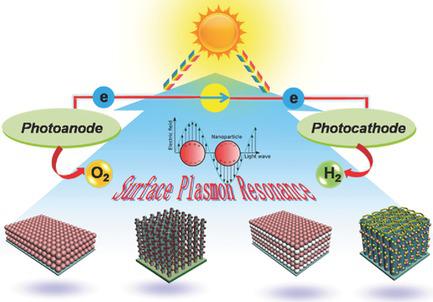当前位置:
X-MOL 学术
›
Adv. Mater. Interfaces
›
论文详情
Our official English website, www.x-mol.net, welcomes your
feedback! (Note: you will need to create a separate account there.)
Plasmon‐Dictated Photo‐Electrochemical Water Splitting for Solar‐to‐Chemical Energy Conversion: Current Status and Future Perspectives
Advanced Materials Interfaces ( IF 4.3 ) Pub Date : 2018-02-12 , DOI: 10.1002/admi.201701098 Fang-Xing Xiao 1 , Bin Liu 2
Advanced Materials Interfaces ( IF 4.3 ) Pub Date : 2018-02-12 , DOI: 10.1002/admi.201701098 Fang-Xing Xiao 1 , Bin Liu 2
Affiliation

|
Surface plasmon resonance (SPR) effect of metal nanostructures is established as an efficient and attractive strategy to boost visible‐light or even near‐infrared‐responsive photo‐electrochemical (PEC) water splitting devices for substantial solar‐to‐chemical energy conversion. Rational integration of plasmonic metal nanostructures with semiconductors in an appropriate fashion is beneficial for creating a large variety of plasmonic metal/semiconductor photoelectrodes. However, up to date, construction of well‐defined and highly efficient plasmonic metal/semiconductor heterostructures is still in its infant stage. In this review, basic principles of PEC water splitting over semiconductors, SPR‐excited plasmonic effect of metal nanostructures, and their intrinsic correlation with each other are first concisely introduced. Subsequently, it is paid great attention to specifically summarize the diverse plasmonic metal/semiconductor photoelectrodes currently being extensively explored for indirect plasmon‐induced PEC water splitting. Particularly, different plasmonic metal/semiconductor nanoarchitectures including planar thin films, 1D composited, and 3D spatially hierarchical heterostructures are systematically classified and elucidated. Finally, future perspectives and challenges in triggering further innovative thinking on plasmon‐enhanced solar water splitting are envisaged. It is anticipated that this review can provide enriched information on rational design and construction of various plasmonic metal/semiconductor heterostructures for solar‐powered plasmon‐based PEC devices.
中文翻译:

用于太阳能转化为化学能的等离激子光电化学水分解:现状和未来展望
金属纳米结构的表面等离振子共振(SPR)效应已被确立为一种有效且有吸引力的策略,可增强可见光或什至是近红外响应的光化学(PEC)水分解装置,以实现大量的太阳能转化为化学能。以适当的方式将等离子体金属纳米结构与半导体进行合理的集成有利于创建多种等离子体金属/半导体光电极。但是,迄今为止,定义良好且高效的等离激元金属/半导体异质结构的构建仍处于起步阶段。在这篇综述中,首先简要介绍了PEC在半导体上进行水分解的基本原理,SPR激发的金属纳米结构的等离子体效应及其相互之间的内在联系。随后,特别要概述目前正广泛用于间接等离激元诱导的PEC水分解的各种等离激元金属/半导体光电极,这一点引起了极大的关注。特别是,系统地分类和阐明了包括平面薄膜,1D复合材料和3D空间分层异质结构在内的不同等离子金属/半导体纳米结构。最后,设想了未来的观点和挑战,以激发对等离激元增强的太阳能水分解的进一步创新思维。可以预期,该审查可以为基于太阳能的等离激元PEC器件的各种等离激元金属/半导体异质结构的合理设计和构造提供丰富的信息。
更新日期:2018-02-12
中文翻译:

用于太阳能转化为化学能的等离激子光电化学水分解:现状和未来展望
金属纳米结构的表面等离振子共振(SPR)效应已被确立为一种有效且有吸引力的策略,可增强可见光或什至是近红外响应的光化学(PEC)水分解装置,以实现大量的太阳能转化为化学能。以适当的方式将等离子体金属纳米结构与半导体进行合理的集成有利于创建多种等离子体金属/半导体光电极。但是,迄今为止,定义良好且高效的等离激元金属/半导体异质结构的构建仍处于起步阶段。在这篇综述中,首先简要介绍了PEC在半导体上进行水分解的基本原理,SPR激发的金属纳米结构的等离子体效应及其相互之间的内在联系。随后,特别要概述目前正广泛用于间接等离激元诱导的PEC水分解的各种等离激元金属/半导体光电极,这一点引起了极大的关注。特别是,系统地分类和阐明了包括平面薄膜,1D复合材料和3D空间分层异质结构在内的不同等离子金属/半导体纳米结构。最后,设想了未来的观点和挑战,以激发对等离激元增强的太阳能水分解的进一步创新思维。可以预期,该审查可以为基于太阳能的等离激元PEC器件的各种等离激元金属/半导体异质结构的合理设计和构造提供丰富的信息。









































 京公网安备 11010802027423号
京公网安备 11010802027423号